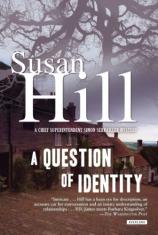A Question of Identity: A Chief Superintendent Simon Serrailler Mystery
Review
A Question of Identity: A Chief Superintendent Simon Serrailler Mystery
Almost all really superior mysteries deal not just with a particular murder and its investigation. They offer sharply drawn psychological and social detail about the detectives, the victims and the setting, and they often have a wider moral compass that leads us to ponder issues of good and evil, sanity and derangement, life and death. A QUESTION OF IDENTITY, the seventh Simon Serrailler novel, qualifies on all counts.
No surprise, for author Susan Hill also writes “straight” novels, albeit sometimes with a rather gothic twist. Among her many works are MRS. DEWINTER, a sequel to Daphne du Maurier’s REBECCA; and a ghost story, THE WOMAN IN BLACK, that was recently made into a film. She definitely belongs to a tradition of serious literary writers dipping into the detective genre. Think of Charles Dickens with THE MYSTERY OF EDWIN DROOD, or G.K. Chesterton’s Father Brown series, or, more recently, the mysteries of John Banville, writing under the pen name Benjamin Black. What’s important is that they respect the conventions of the genre even while transcending them.
In some respects, A QUESTION OF IDENTITY is a traditional police procedural, and, like all the books in the series, it takes place in Lafferton, a fictional (but very believable) cathedral town in the south of England. The cases are heartbreaking, for the murder victims are women living alone in a senior housing community dubbed, rather pretentiously, Duchess of Cornwall Close. In just a few pages, Hill gives us a profound sense of these women’s loneliness, determination, vulnerability and intelligence, and we mourn them.
"Over seven titles, Susan Hill has had the space and time to develop these characters more deeply than ever would have been possible in a single novel."
Now, here’s the twist. As Chief Superintendent Serrailler begins to investigate, he discovers that the killer’s modus operandi is identical to that of three murders committed in Yorkshire --- specifically, in a housing complex called Meadow View Close --- 10 years ago. The culprit, Alan Keyes, was arrested and tried, but found not guilty when a key witness was bullied into changing her testimony. To protect Keyes’s life against an enraged community, a top-secret police department known only as “Floor Five” gave him a new identity. For a decade he remained anonymous --- until the murders in Lafferton revealed that somewhere, the man who used to be Keyes was still alive, and still deadly. But how do you track down a killer whose former name no longer exists? How do you recognize a man whose appearance has been altered?
It is obvious how the book’s title, A QUESTION OF IDENTITY, applies to Keyes. But it is equally relevant to other characters in the book, including the chief superintendent himself. There is no doubt in the reader’s mind that Serrailler, a gifted artist and close to a genius at crime-solving, will unravel the murders. But this brilliant detective has been less than stellar at forming and sustaining relationships. He has a poor track record with women, and his current liaison with Rachel, married to a man in the late stages of a terminal illness, is morally ambiguous enough to keep him at a slight remove even from this infinitely desirable and patient woman: “Rachel never demanded, never blamed. She accepted him as he was, loved him for that. Yet still he sometimes felt a desperate need to dodge, to run, to shut her out.”
His widowed sister, Cat, is clinical director of a hospice, and she too grapples with issues of personal and professional identity. Her two older children, meanwhile, are still reverberating from the loss of their father, and she counts on Serrailler to help. In fact, when we first encounter the detective, he is on a week-long trip to Norfolk with his troubled 14-year-old nephew, Sam, who has never opened up about his father’s death four years before. You can see them there on the frozen beach: Serrailler with his sketchbook, Sam with his earphones; not talking but content. “Simon was sure that Sam would not share his feelings. He was not like his mother, nor the kind of open, cheerful character his father had been. Sam was like him.” In other words, a loner.
There is also a huge question mark about the relationship between Serrailler’s own father and stepmother. Is the elder Serrailler merely irascible, or something worse? All in all, there is plenty of identity crisis, darkness and death in this novel, and it is not related exclusively to Alan Keyes.
Of course, Serrailler and his family, however neurotic, are personalities of considerable solidity and consistency, despite change and loss --- very different from the psychopath whose crimes are the motor of this book. They are complex, attractive individuals; indeed, what makes these novels satisfying is not so much the cleverness of the plot as the ongoing story of the Lafferton community and Serrailler’s private life. (I guessed the killer’s identity about two-thirds of the way through, and it didn’t spoil my pleasure one bit.)
Over seven titles, Susan Hill has had the space and time to develop these characters more deeply than ever would have been possible in a single novel. That’s why, if you haven’t yet discovered the Serrailler series, I would recommend reading it in order. Start with THE VARIOUS HAUNTS OF MEN, and keep your evenings free. You won’t be able to stop at just one.
Reviewed by Kathy Weissman on December 7, 2012





